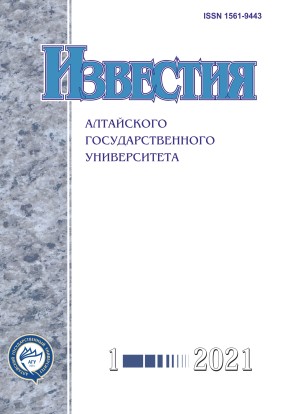Basis Set Selection for Calculation of Structural and Electronic Properties of Systems Incorporating a Superoxide Radical in an Aqueous Medium
УДК 541.1
Abstract
In this work, computer simulation has been carried out, and the molecular parameters of oxygen and a superoxide ion have been calculated to select the most optimal basis set of functions for further quantum mechanical calculations that include the presence of reactive oxygen species. For each particle, the equilibrium bond lengths and averaged polarizabilities in a continuous dielectric aqueous medium are obtained with the Conductor-like Polarizable Continuum Model (CPCM) and Solvation Model based on Density (SMD). Calculations for the 16 basic sets are conducted using the Orca software package. The obtained numerical values are compared with experimental data. The electron affinity energy of the oxygen molecule is used as the main selection criterion. The total time of computer calculations for each basis set is considered, and the most optimal basis sets are selected. The basis sets 6-31+G(d), 6-311+G, def2-TZVPD, and aug-cc-pVDZ are recommended for numerical calculations of molecular systems incorporating molecular oxygen and superoxide radical as its reduction product.
Downloads
Metrics
References
Barja G. Mitochondrial Oxygen Radical Generation and Leak: Sites of Production in States 4 and 3, Organ Specificity, and Relation to Aging and Longevity // J. Bioenergetics and Biomembranes. 1999. Vol. 31.
Dawson T.M., Dawson V.L. Molecular Pathways of Neurodegeneration in Parkinson’s Disease // Science. 2003. Vol. 302 (5646). DOI: 10.1126/science.1087753.
Rienstra-Kiracofe J.C., Tschumper G.S., Shaefer H.F. Atomic and molecular electron affinities: photoelectron experiments and theoretical computations // Chem. Rev. 2002. Vol. 102. DOI: 10.1021/cr990044u.
ORCA, An Ab Initio, DFT and Semiempirical electronic structure package. Version 4.2.0. Department of theory and spectroscopy. Directorship: Frank Neese. Max Planck Institute fuer Kohlenforschung, Kaiser Wilhelm Platz 1, D-45470 Muelheim/Ruhr, Germany. 2019. URL: www. orcaforum.kofo.mpg.de.
Krishnan R., Binkley J.S., Seeger R., Pople J.A. Self-consistent molecular orbital methods. XX. A basis set for correlated wave functions // J. Chem. Phys. 1980. Vol. 72. DOI: 10.1063/1.438955.
Gill PM.W, Johnson B.G., Pople J.A., Frisch M.J. The performance of the Becke—Lee—Yang—Parr (B—LYP) density functional theory with various basis sets // Chem. Phys. Lett. 1992. Vol. 197. DOI: 10.1016/0009-2614(92)85807-M.
Weigend F., Ahlrichs R. Balanced basis sets of split valence, triple zeta valence and quadruple zeta valence quality for H to Rn: Design and assessment of accuracy // Phys. Chem. Chem. Phys. 2005. Vol. 7. DOI: 10.1039/b508541a.
Kendall R.A., Dunning T.H., Harrison R. J. Electron affinities of the first-row atoms revisited. Systematic basis sets and wave functions // J. Chem. Phys. 1992. Vol. 96. DOI: 10.1063/1.462569.
Cossi M., Rega N., Scalmani G., Barone V., Energies, Structures, and Electronic Properties of Molecules in Solution with the C-PCM Solvation Model // Chem. Phys. 2003. Vol. 24. № 6. DOI: 10.1002/jcc.10189.
Marenich A.V., Cramer C.J., Truhlar D.G. Universal Solvation Model Based on Solute Electron Density and on a Continuum Model of the Solvent Defined by the Bulk Dielectric Constant and Atomic Surface Tensions // J. Phys. Chem. B. 2009. Vol. 113, 18. DOI: 10.1021/jp810292n.
Huber K.P, Herzberg G., Molecular Spectra and Molecular Structure: IV Constants of Diatomic Molecules. New York, 1979. DOI: 10.1007/978-1-4757-0961-2.
Olney T.N., Cann N.M., Cooper G., Brion C.E. Absolute scale determination for photoabsorption spectra and the calculation of molecular properties using dipole sum-rules // Chem. Phys. 1997. Vol. 223. DOI: 10.1016/S0301-0104(97)00145-6.
Рябых А.В., Маслова О.А., Безносюк С.А., Жуковский М.С., Масалимов А.С. Компьютерное моделирование устойчивости супероксид-иона O2- в континуальной диэлектрической среде // Известия АлтГУ 2020. № 1. DOI: 10.14258/izvasu(2020)1-05.
Izvestiya of Altai State University is a golden publisher, as we allow self-archiving, but most importantly we are fully transparent about your rights.
Authors may present and discuss their findings ahead of publication: at biological or scientific conferences, on preprint servers, in public databases, and in blogs, wikis, tweets, and other informal communication channels.
Izvestiya of Altai State University allows authors to deposit manuscripts (currently under review or those for intended submission to Izvestiya of Altai State University) in non-commercial, pre-print servers such as ArXiv.
Authors who publish with this journal agree to the following terms:
- Authors retain copyright and grant the journal right of first publication with the work simultaneously licensed under a Creative Commons Attribution License (CC BY 4.0) that allows others to share the work with an acknowledgement of the work's authorship and initial publication in this journal.
- Authors are able to enter into separate, additional contractual arrangements for the non-exclusive distribution of the journal's published version of the work (e.g., post it to an institutional repository or publish it in a book), with an acknowledgement of its initial publication in this journal.
- Authors are permitted and encouraged to post their work online (e.g., in institutional repositories or on their website) prior to and during the submission process, as it can lead to productive exchanges, as well as earlier and greater citation of published work (See The Effect of Open Access).








